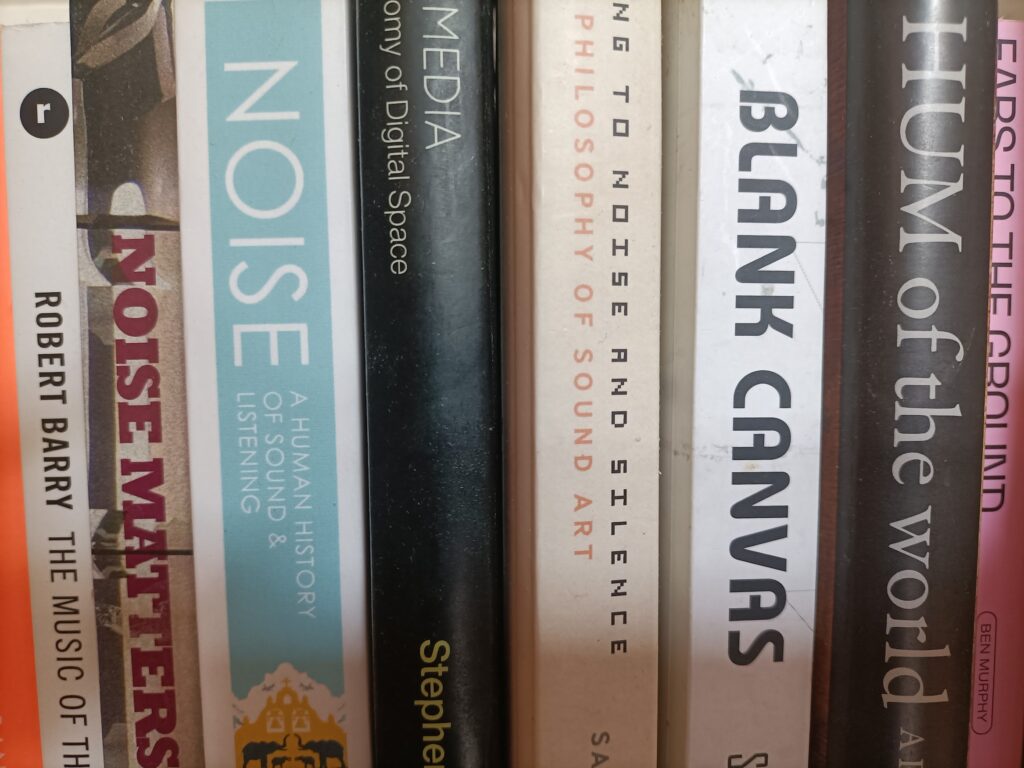The following books serve as an introduction to experimental sound design and theory. They provide a thorough grounding in the principles, history, and techniques of experimental sound design, offering valuable insights for both beginners and advanced practitioners in the field. This list from Music Modular is also worth checking out also.

Adorno, T.W. & Leppert, R. eds (2002) Essays on Music, University of California Press (1st Edition)
Attali, J. (1977) Noise, The Political Economy of Music, University of Minnesota Press.
Barry, R. (2017) The music of the future. London: Repeater Books.
Battier, M. (2007) Electroacoustic Music: Analytical Perspectives. New York: Routledge.
Battier provides analytical tools for understanding electroacoustic music, focusing on the relationships between sound materials and structures.
Chadabe, J. (1997) Electric Sound: The Past and Promise of Electronic Music. Upper Saddle River, NJ: Prentice Hall.
Chadabe’s book offers a comprehensive history of electronic music, discussing key figures, technologies, and compositions.
Chion, M. (1994) Audio-Vision: Sound on Screen, New York: Columbia University Press.
Cox, C. and Warner, D. (2004) Audio Culture: Readings in Modern Music. New York: Continuum.
This anthology compiles seminal writings on sound art and experimental music, offering a comprehensive introduction to the field.
Collins, N. (2009) Introduction to Computer Music. Chichester: Wiley.
This text introduces the fundamentals of computer music, covering topics from synthesis to algorithmic composition, essential for experimental sound designers.
Collins, N., McLean, A., Rohrhuber, J. and Ward, A. (2003) The SuperCollider Book. Cambridge, MA: MIT Press.
A detailed guide to the SuperCollider programming language, this book is indispensable for those interested in real-time audio synthesis and algorithmic composition.
Cox, T. (2014) Sonic Wonderland: A Scientific Odyssey of Sound, Vintage Digital.
Dean, R.T. (2009) The Oxford Handbook of Computer Music. Oxford: Oxford University Press.
This handbook covers a wide range of topics in computer music, including algorithms, software, and performance practices, making it an essential resource for experimental sound designers.
Diduch, R. (2018) Mad Skills: MIDI and Music Technology in the Twentieth Century (ebook), Repeater.
Dyson, F. (2009) Sounding New Media: Immersion and Embodiment in the Arts and Culture, University of California Press.
Dyson, F. (2015) The Tone of Our Times: Sound, Sense, Economy and Ecology, MIT Press.
Emmerson, S. (1986) The Language of Electroacoustic Music. London: Macmillan.
Emmerson explores the terminology and theoretical underpinnings of electroacoustic music, making it a key text for understanding sound manipulation.
Erickson, R. (1975) Sound Structure in Music. Berkeley: University of California Press.
Erickson’s text is an analytical approach to understanding the structural aspects of music, valuable for sound designers looking to understand complex compositions.
Gayraud, A. (2020) Dialectic of pop agnes gayraud. S.l.: Urbanomic.
Goddard, M. Halligan, B, Hegarty, P, (2012) Reverberations : Resonances, Noise and Contemporary Music, Continuum.
Goddard, M Halligan B, Spelman, N (2013) Resonances: Noise and 213 Contemporary Music, Continuum.
Gunkel, D,J. (2016) Of Remixology: Ethics and Aesthetics after Remix, MIT Press.
Harper, A. (2010) Infinite Music: Imagining the Next Millennium of Human
Hainge, G. (2013) Noise Matters – Towards and Ontology of Noise, Bloomsbury Acacemic.
Holmes, T. (2020) Electronic and Experimental Music: Technology, Music, and Culture. 6th edn. New York: Routledge.
Holmes’ book is a comprehensive history of electronic and experimental music, detailing the technological advances and cultural shifts that shaped the genre.
Hegarty, P. (2007) Noise Music, Continuum.
Heylin, C. (1993) From the Velvets to the Voidoids: A Pre-Punk History for a Post-Punk World, Blackwell.
Idhe, D. (2007) Listening and Voice, Phenomenologies of Sound, State University of New York Press.
Kahn, D. (2001) Noise, Water, Meat: A History of Sound in the Arts. Cambridge, MA: MIT Press.
This book traces the history of sound art, examining how noise and other non-musical sounds have been used in artistic practices.
Katz, M. (2004) Capturing Sound: How Technology has Changed Music, Berkely University of California Press.
Kahn, D. (2001) Noise, Water, Meat: A History of Sound in the Arts, The MIT Press.
Kennedy, S. (2020a) Future sounds: The temporality of noise. New York: Bloomsbury Academic.
Kosko, B. (2006), Noise, Viking Penguin.
Krapp, P. (2011) Noise Channels: Glitch and Error in Digital Culture: London: University of Minnesota Press.
Kramer, L. (2021) The hum of the world: A philosophy of listening. Oakland, CA: University of California Press.
Krukowski, D. (2017) The New Analogue, The New Press.
LaBelle, B. (2006) Background Noise: Perspectives on Sound Art. New York: Continuum.
LaBelle examines sound art from various perspectives, discussing how artists use sound to engage with space and context.
Landy, L. (2007) Understanding the Art of Sound Organization. Cambridge, MA: MIT Press.
Landy examines the creative processes behind organizing sound, providing insight into both theory and practice of sound design.
Levinson, J. (1990) Music, Art, and Metaphysics, Cornell University Press.
Miller, P.D, eds(2010) Sound unbound: Sampling digital music and culture. Cambridge, Mass: MIT Press.
Moore, A. (1990) Innovations in Music Technology. Cambridge: Cambridge University Press.
- Moore explores technological innovations in music, providing insights into the tools and techniques used in experimental sound design.
Monacelli, E. (2023) The Great Psychic Outdoors Adventures in Low Fidelity. New York: Watkins Media.
Murphy, B. (2024) Ears to the ground adventures in field recording and electronic music. Bristol: Velocity Press.
Nancy, J. (2007) Listening, New York: Fordham University Press.
Nechteval, J. (2011) Immersion Into Noise, Open Humanities Press.
Novak, D. (2013) Japanoise: Music at the Edge of Circulation, Duke University.
Prendergast, M. (2000) The Ambient Century: From Mahler to Trance – The Evolution of Sound in the Electronic Age. New York: Bloomsbury Publishing.
This book provides a historical overview of ambient music and its evolution, highlighting key developments in experimental sound design.
Pinch, T.J. and Trocco, F. (2002). Analog days: The invention and impact of the Moog Synthesizer. Cambridge, Mass.: Harvard University Press. Pinch, T. (2008) Technology and Institutions: Living in a Material World,
Randall, D. (2017) Sound system: The political power of Music. London: Pluto Press.
Roads, C. (2004) Microsound. Cambridge, MA: MIT Press.
Roads explores granular synthesis and other microsound techniques, offering deep insights into the minutiae of sound particles.
Ross, A. (2007) The Rest is Noise: Listening to the Twentieth Century. New York, Farrar, Straus and Giroux.
Savage, J. (2008) Teenage: The Creation of Youth 1985-1945, Pimlico. Serres, M. (1980) The Parasite, Baltimore.
Schaeffer, P. (1966) Treatise on Musical Objects: An Essay across Disciplines. Berkeley: University of California Press.
Schaeffer’s foundational text on musique concrète explores the philosophy and practice of using recorded sounds as compositional material.
Schafer, R.M. (1993) “Music, Non-Music and the Soundscape”, in Paynter et al (eds) The Companion to Contemporary Thought Musicsoundscape: our sonic environment and the tuning of the world, Rochester, Routledge.
Smalley, D. (1996) Spectromorphology: Explaining Sound-Shapes. London: Cambridge University Press.
Smalley introduces spectromorphology, a framework for analyzing the temporal and spectral qualities of sound, essential for experimental sound design analysis.
Smirnov, A. (2013) Sound in Z: Experiments in Sound and Electronic Music in Early 20th Century Russia, London.
Sterne, J. (2012) MP3: The Meaning of a Format (Sign, Storage,
Stubbs, D. (2009) Fear of Music: Why People Get Rothko But Don’t Get Stockhausen, Zero Books.
Sullivan, P. (2014) Remixology: Tracing the dub diaspora. London: Reaktion Books.
Thompson, M. (2017) Beyond Unwanted Sound, Noise, Affect and Aesthetic Moralism, Bloomsbury.
Truax, B. (1984) Acoustic Communication. Norwood, NJ: Ablex Publishing.
Truax discusses the interaction between sound and the environment, making it crucial for understanding context in sound design.
Vail, M. (2002) The Synthesizer: A Comprehensive Guide to Understanding, Programming, Playing, and Recording the Ultimate Electronic Music Instrument. New York: Oxford University Press.
This guide covers all aspects of synthesizers, from basic principles to advanced programming techniques, essential for any sound designer.
Voegelin, S. (2010) Listening to Noise and Silence, Towards a Philosophy of Sound Art, Continuum.
Warner, D. (2004) Audio Culture: Readings in Modern Music. New York.
Wishart, T. (1996) On Sonic Art. New York: Routledge.
Wishart’s work is a theoretical exploration of sonic composition, with a particular focus on the physical and perceptual properties of sound.
Wilmer, V. and Williams, R. (2018) As serious as your life: Black Music and the Free Jazz Revolution, 1957-1977. London: Serpent’s Tail.
Young, R. (eds.) (2002) Undercurrents: The Hidden Writing of Modern Music, London: Continuum.
The Foley Grail: The Art of Performing Sound for Film, Games, and Animation
